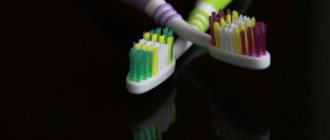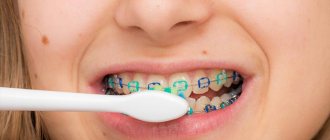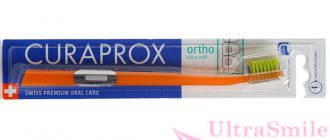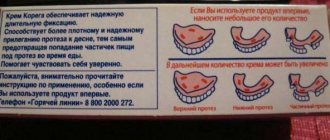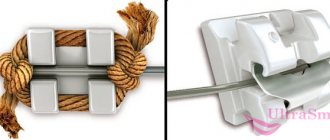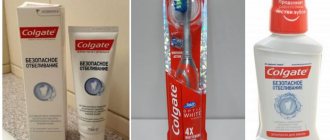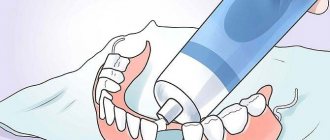The comfort of wearing and the service life of dentures depend not only on the work of the dentist, but also on the behavior of the patient.
He must follow the doctor's recommendations and ensure proper care of the orthodontic structure.
A mandatory component of the process is the use of a special toothbrush . It should be designed for high-quality cleaning of both removable and non-removable structures.
Types of brushes for dentures - the best brands, cleaning features, prices
Article navigation
- Special brush for dentures
- Peculiarities
- Types of brushes
- How to use
- Rating and cost of popular models
- Features of storage and care
- Alternatives
Question for a specialist
We are all used to brushing our teeth in the morning and evening with a toothbrush. Some people use soft, some medium, and some prefer hard for cleaning. But people with orthopedic structures in their mouths need a special brush for dentures. And not only for removable ones - for non-removable ones too, so that the new teeth last as long as possible and delight the eye with high aesthetics. Next, we will talk about what a toothbrush for dentures should be like, how to use it correctly, and what types of regular ones can be used for cleaning.
Recommendations for the care of dentures and the oral cavity - additional means
Just like natural teeth, removable dentures require regular care and daily cleaning. Bacterial plaque appears on orthodontic structures, and food debris settles in hard-to-reach corners. After each meal, removable dentures should be removed, cleaned with a toothbrush, and the mouth should be rinsed.
In addition to a toothbrush, special cleaning tablets, soluble in a glass of clean water, are used to care for removable structures. The prosthesis must be placed in this solution, after first rinsing it in running water. Bacterial plaque is completely removed from the structure placed in the solution within 10-15 minutes. The tablets contain biologically active substances that clean the denture where it is difficult to reach mechanically, using a toothbrush. The solution does not damage the surface of the prosthesis and eliminates bacteria that cause an unpleasant odor. The tablets should be taken twice a day, morning and evening.
Such cleaning tablets and other products for the care of removable dental structures can be purchased at the pharmacy. The most popular of them are “President” tablets, “Protefix”, and “Corega”.
"President"
Soluble effervescent tablets from an Italian manufacturer for cleaning dentures. Remove stubborn dirt, stains, and bacterial plaque using a structure consisting of three different layers. The first layer, blue, is aimed at whitening the surface and cleaning. The second layer, white, removes more stubborn stains and plaque. The third, red layer, has a disinfecting effect, it contains only natural ingredients - mint and rosemary extract. As a result, the denture is cleaned of contaminants and acquires a fresh mint aroma. There are 32 tablets in a package.
The average cost is 291 rubles.
Advantages:
- The tablets thoroughly clean even hard-to-reach areas and bends of the structure;
- economical use;
- well suited for cleaning systems for correcting bites;
- gives a feeling of freshness;
- natural ingredients.
Flaws:
- not detected.
"Corega"
A product for daily denture care that removes plaque and refreshes the oral cavity. Corega provides deep cleansing without the need to leave the denture in the solution overnight - in three minutes this product removes bacteria that cause unpleasant odors, plaque and stains. As a result, the prosthesis becomes clean and fresh. This type of cleaning of dental structures does not scratch the surface because, unlike ordinary toothpastes, it does not contain abrasive substances.
The average cost is 453 rubles.
Advantages:
- cleans quickly and effectively;
- whitening effect;
- freshness and cleanliness.
Flaws:
- high price.
Do you need a special brush for dentures and why?
According to orthopedic dentists, a toothbrush for cleaning dentures, especially for removable ones, should be separate and have special characteristics. In essence, a denture is an imitation (even a very good one) of natural teeth. And if people know how to brush their own teeth, then with artificial ones they can get the misleading impression that they do not need cleaning, but only, for example, rinsing with water or soaking overnight.
But artificial materials - acrylic (plastic), nylon, ceramics, composite and even metal - can become damaged over time. For example, from hard pieces of food or sour foods. As a result, soft food deposits settle in the cracks formed, as well as harmful microbes. As for plastic, its surface has tiny pores in which plaque and dyes (from food, drinks or tobacco) are retained even without external aggressive factors. Ceramic and composite materials can be painted. Another nuance is that the denture follows the shape of the teeth and gums, i.e. has small tubercles and depressions in which plaque also settles.
Features of Cleaning Tools
A toothbrush for both removable and fixed dentures must have the following qualities:
- high-quality bristles: as a rule, this is synthetic bristles - natural bristles tend to become moldy if poorly washed and dried. Each bristle is rounded at the end to avoid scratching artificial materials,
- thick bristles: to remove large amounts of plaque in a few strokes,
- the bristles are arranged in a special order: it can be a zigzag, a wedge, a bunch - to clean hard-to-reach places,
- comfortable brush handle: as a rule, it is small for removable dentures, which are cleaned by removing them from the mouth. For non-removable ones, it is more convenient to use a tool with a standard length handle. Also, the handle should be ergonomic and not slip in the hand.
Don't know what type of prosthetics to choose?
We will help in the selection, advise where to read more information and compare types of prosthetics.
Consultation with an orthopedic doctor in Moscow clinics is free! Call now or request a call
Working hours: from 9:00 to 21:00 - seven days a week
“We recently gave our granny a special brush for her dentures. It is different from the usual one. The bristles are longer and there seem to be more of them, and on the back there is a tuft of bristles. Grandma says that it’s convenient to use, the handle doesn’t slip and cleans well in all places.”
Tatyana_93, review from otzovik.com
Types of hygiene instruments
Specialized brushes for cleaning dentures differ in the location of the bristles, their shape, the length of the bristles and handles, direction, and bend. The following classification of hand tools can be distinguished:
- double-sided (most popular): The bristles are on both sides of the head of a denture toothbrush. For example, on the one hand it can be a tuft or wedge-shaped arrangement of villi, on the other hand it can be flat or zigzag bristles. The handle is shortened, slightly curved for convenience,
- one-sided: similar to a regular brush for oral hygiene, because The bristles are located on one side only - they can be zigzag-shaped or flat. As a rule, the handle of such a tool is short,
- monotuft: the head contains a thin tuft of rounded bristles and has a thin handle.
These tools can be used to clean not only orthopedic structures, i.e. prostheses, but also orthodontic ones - braces, plates, aligners, mouth guards (for example, whitening and for people with bruxism), as well as sports mouth guards. Miniature tools – brushes – can also be used for cleaning. They consist of a short handle and a vertical wire, which is entwined with bristles. Brushes are used for cleaning between crowns, bridges, clasps, restorations on implants and natural teeth.
PROSTHETIC PROSTHETICS WITH 4 STRAUMANN IMPLANTS “teeth in 1 day” - RUB 220,000. until January 15, 2022!
Complex implantation using ProArch technology (Switzerland) with immediate loading on the day of surgery!
Call now or request a call
The bristles of a toothbrush for cleaning dentures can be soft - this is exactly the modification most manufacturers offer, as well as ultra-soft and medium hard. The dentist will tell you which one is better to choose after assessing the condition of the teeth, gums and its relationship with the materials used for prosthetics.
How to use it correctly
Using a toothbrush for dentures is not difficult - you can learn this simple technique in just 1 brushing. By the way, the orthopedist himself can tell you how to clean it correctly, but some doctors miss this point. Therefore, further we will talk about the nuances of oral hygiene with fixed and removable orthopedic structures.
Cleaning fixed dentures
Here, the technique and regularity of brushing is not much different from caring for your own teeth. First, wet the brush, apply 1 pea of special paste to the bristles, then distribute it evenly over the surface of the denture. Crowns, bridges and fixed implant structures are cleaned using sweeping movements from the gums to the cutting crown. The chewing surface of the crowns is cleaned using back and forth movements. Additionally, you can massage your gums in a circular motion for 15-20 seconds - this will maintain their tone. Then you need to rinse your mouth twice.
Interesting to know! This method is suitable not only for fixed, but also for some removable orthopedic structures that do not need to be removed from the mouth every day - these are clasp and conditionally removable on implants.
%akc52%
Cleaning removable dentures
Removable structures are cleaned outside the oral cavity (even after each meal, but at least 2 times a day - morning and evening). To do this, they are first removed from the mouth or from a special box and washed well in water. Then, as in the previous point, the paste is squeezed onto a brush moistened with water, and the substance is distributed over the surface from all sides - outside and inside, under the artificial gum. Next, clean the denture thoroughly using circular movements, but without strong pressure. Depending on the length of the structure, cleaning may take 3-10 minutes. Next, the product is washed with clean water and dried if necessary. Then you can apply a fixing cream to it and install it in the oral cavity.
A similar cleaning method can be carried out after weekly disinfection of the prosthesis in a special solution. After soaking, the structure is cleaned in the same way, but without using toothpaste.
Why do you need a denture brush?
Substances, microorganisms and bacteria that naturally occur and accumulate in the oral cavity have a harmful effect not only on the natural surface of the teeth, but also on the artificial material of dentures. If care is not taken carefully, bacteria accumulating under the structure gradually causes an unpleasant odor to appear, and subsequently inflammation.
A toothbrush, in addition to thorough cleansing, massages the gums; this is important for maintaining healthy blood circulation, which can be disrupted when wearing a removable structure.
A toothbrush for dentures differs from a regular one not only in the softness of the cleaning surface - it has bristles on both sides, one of which is intended for the outer surface. It usually has a straight or zigzag shape. The side for cleaning the inner surface of the structure has a rounded shape.
Rating and cost of popular models
Double-sided Curadent model from Curaprox
Double-sided instrument with ergonomic handle for removable orthopedic structures. On one side of Curadent (“Curadent” from “Curaprox”) there is dense, flat-shaped bristles, on the other there is a spiral-shaped brush for hard-to-reach areas. The cost is about 1400 rubles. The instrument can be replaced with the classic soft Curaprox “soft”/”ultrasoft” or supplemented with the monobeam Curaprox cs1006 “single & sulcular”.
Double-sided model Paro Prothesen
Double-sided Paro Prothesen is a combination of flat bristles and a tuft of bristles located on different sides of the head. The five-layer bristles include hard and soft bristles for thorough cleansing. The manufacturer recommends cleaning carefully, without bending the hooks (clasps) and clasps (attachments) of the orthopedic design. The average price of a product is 350 rubles.
Double-sided model Protho Brush De Luxe from Miradent
Protho brush de luxe is designed specifically for patients with poor hand motor skills. The octagonal handle of a special ergonomic shape fits comfortably in the hand. This allows you to efficiently clean the prosthetic structure from all sides, even with weak and not very precise movements. The average price is 320 rubles.
Double-sided Denture Brush model from Y-Kelin
The miniature Denture Brush from Y-Kelin (about 10 cm long) is convenient for both home use and travel. The double-sided head with medium-hard bristles effectively cleans hard-to-reach areas. The instrument is safe for the body, because Made from high quality food grade plastic. Cost – 280 rubles.
Bilateral model Pro-Expert Clinic Line from Oral-B
The Pro-Expert Clinic Line double-sided brush for dentures has flat bristles on one side of the head and wedge-shaped bristles on the other for cleaning hard-to-reach areas. Consists of synthetic materials. Also suitable for cleaning orthodontic appliances. The average price is 270 rubles.
Bilateral PresiDENT Denture
PresiDENT Denture contains 2 types of bristles of varying degrees of stiffness. Short pile is intended for cleaning the surface of orthopedic structures. Long pile is intended for “secluded” or hard-to-reach areas. The average cost is 270 rubles.
SILCAMED set (paste + double-sided brush)
The SILCAMED set consists of a soft double-sided brush with a comfortable handle and gel paste. On one side of the head of the instrument there is a small tuft of bristles; on the other side the bristles are flat and thick. The cost of the set is about 250 rubles.
Double-sided Protheses from Fuchs
The Fuchs Protheses brush is also double-sided and has 2 types of bristles. Angled bristles - with the help of which hard-to-reach areas and recesses are cleaned. Straight and long are designed to care for the rest of the surface - removing food plaque and bacterial film. The average price is 160 rubles.
Single-sided Denture model from TePe
Denture polyamide bristles from TePe are created in such a way that dangerous microbes and food deposits do not linger on it (of course, after washing the instrument). The manufacturer notes that the brush is easy to use, the shape of the bristles is maintained for a long time, which allows for high-quality cleaning of the prosthetic structure for a long time. The cost is about 280 rubles.
Single-sided Prosthesis model from Pierrot
Pierrot Prosthesis is single-sided, but contains a large number of flexible bristles with a straight outline. Effectively and carefully cleans the structure from dirt, i.e. preserves the original appearance of the product and prevents dental diseases. Suitable for orthodontic appliances. The average cost is 230 rubles.
Popular brands
The products of the following manufacturers are in great demand:
- Oral-B pro-expert clinic line. The configuration of toothbrushes from this company is designed for cleaning dentures in hard-to-reach places - thanks to the wedge-shaped bristles, you can thoroughly clean the inside of the structure and its bends.
- Oral-B pro-expert clinic line Denture Brush. Products in this line have a flat bristle surface to achieve maximum contact with the surface. The pointed bristles thoroughly clean hard-to-reach areas of the structure, inside sides and curves.
- Fuchs. Brushes from this company are equipped with double-sided heads with bristles on both sides to achieve maximum cleaning of the prosthesis. The long, straight bristles are angled to clean into nooks and crannies.
- PresiDent. Models from this company have two levels of bristle hardness (medium and hard). The bristles themselves have different lengths, so they simultaneously affect both the surface of the structure and hard-to-reach places.
Features of storage and care
Before first use, be sure to wash your denture toothbrush with soap and running water, and always rinse it after use. The tool should be stored vertically, with the bristles facing up, so that water can flow freely from the bristles. The cup or storage clips should be open or well ventilated. You can store the product in a special box with a built-in bactericidal lamp. Once a week, it is recommended to soak the instrument in a disinfectant solution or in mouth rinse for about 10-15 minutes. Do not forget that you need to change the brush to a new one every 2-3 months and after each illness.
Read on the topic: how to properly care for “old” and “new” teeth after dentures - useful recommendations in one article.
Terms of use
For your information! To keep your denture in good condition and extend its service life, you should learn how to properly care for your orthodontic structure.
The cleaning procedure using special dental appliances must be carried out as follows:
- Remove the denture and rinse it with boiled water , removing visible food debris. If desired, before cleaning, the artificial apparatus can be placed in a container with vinegar solution for 15-20 minutes.
- Apply a small amount of low abrasive toothpaste or cleaning gel to the working head of the special device First you need to wet the brush with warm water. It is better to avoid using whitening pastes and choose children's pastes or products designed specifically for cleaning dentures. They are absolutely safe for artificial materials and are sold in any pharmacy.
- Using light circular movements, clean the inside and outside of the device. It is important not to put pressure on artificial teeth . It is worth remembering that, unlike natural teeth, the structure is quite fragile. Therefore, plaque must be removed carefully.
- Use the back of the working head or a mono-beam brush to clean the interdental areas , holding the device at an angle of 45 degrees to the plane of the tooth. Using smooth sweeping movements, also clean the top of the device.
- It is necessary to clean the structure for 4-5 minutes , after which rinse it well with warm water. Typically, dentures are cleaned twice a day. However, for patients who use fixing agents to securely secure the structure in the oral cavity, one time is enough.
- Dry the denture with a paper towel or soft, clean cloth and place it in the mouth.
You should know! Before carrying out the procedure, experts advise laying a towel on the bottom of the sink.
This will help reduce the risk of damage to artificial jaws if the device slips out of your hands.
Are there alternatives to brushes?
At home, you can replace the brush for cleaning dentures with a classic or children's brush - but they must have soft or ultra-soft bristles. But the answer to the question whether it is possible to clean dentures with an electric brush will be negative. After all, such a tool creates high-frequency vibrations, which can damage the structure or its fixation to the teeth.
As an addition to daily care, you can purchase an irrigator. This device is designed to thoroughly wash away food debris and cleanse the subprosthetic space. For preventive purposes, it is recommended to undergo a medical examination with your orthopedic dentist 2 times a year. The doctor will examine the oral cavity for diseases and the prosthetic structure to identify breakages and hard deposits on the surface. The latter are formed due to poor oral hygiene and cannot be removed independently. But clinics have special equipment for professional1 cleaning, after which the prosthesis looks like new.
Features of such brushes
Different models of devices for cleaning dental structures may differ from each other in their configuration and shape.
However, such devices have a general functional purpose and a number of specific features .
These include:
- rounded bristles to remove plaque from the concave side of the base of the removable structure;
- zigzag bristles on one side, cleaning the outer surface of the prosthesis;
- the presence of villi that eliminate food debris and bacterial plaque formed in hard-to-reach areas.
Stay up to date! The bristles of such a cleaning product should be of medium hardness or soft.
After all, they should not damage the structure and carefully but effectively clean it of dirt.
User Questions
QUESTION Hello, there are stains on my removable denture that cannot be cleaned with a denture brush. I tried the regular one, it doesn’t help either. Maybe I need to clean it with a stiff brush or buy a special whitening paste? Evgeniy V.
ANSWER Hello, Evgeniy. You should not “torture” your dentures with hard brushes, whitening pastes with aggressive substances or abrasives. This way it will quickly lose its appearance and may even break. If difficult-to-remove stains, plaque, or growths appear on the orthopedic structure, then the best option is to take the prosthesis to the dentist, where there is special equipment for professional cleaning. Such a service costs very little, but its effect is preserved as long as possible.
1Nikolaev A.I., Tsepilov L.M. Professional and individual oral hygiene in adults, 2022.
Author: Chernov A. R. (Thank you for your help in writing the article and the information provided)
